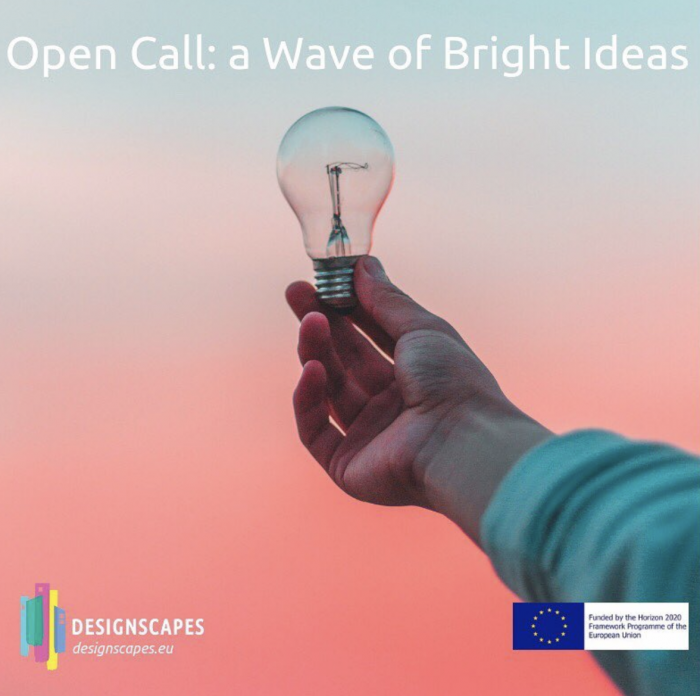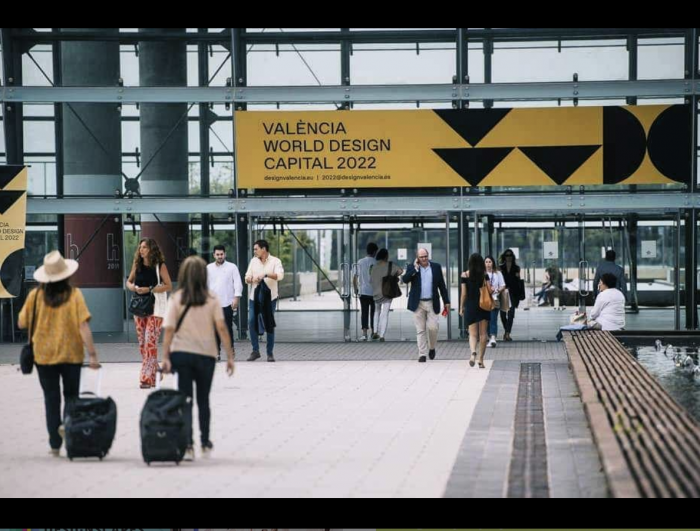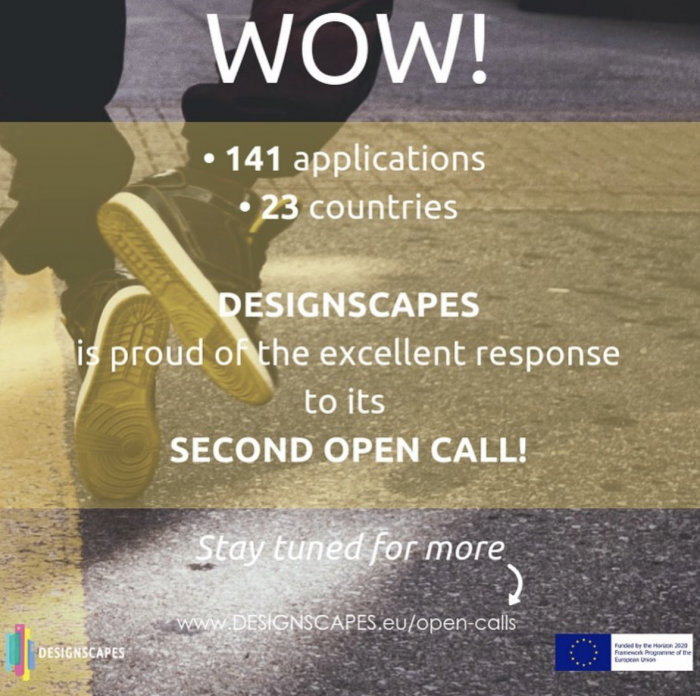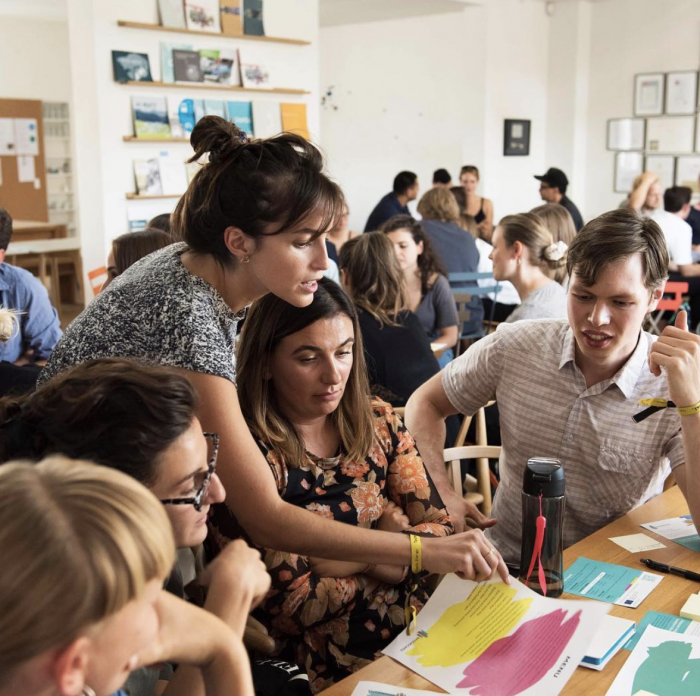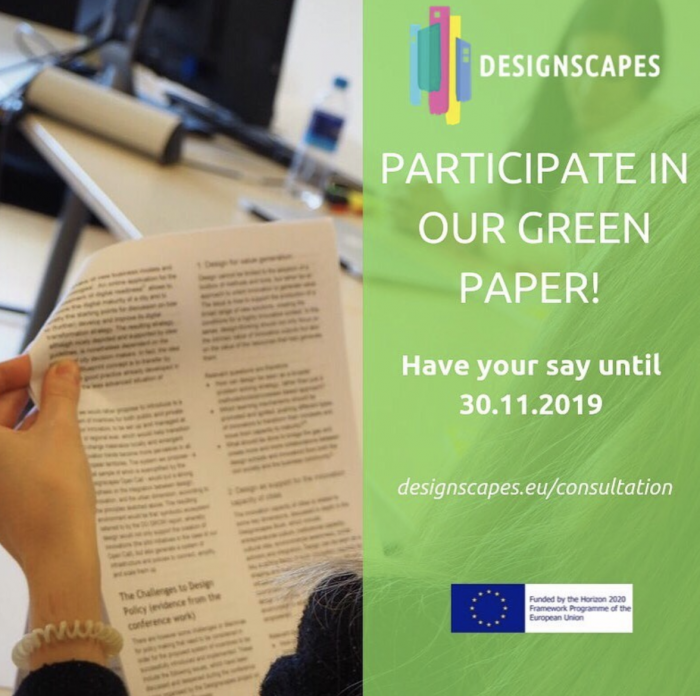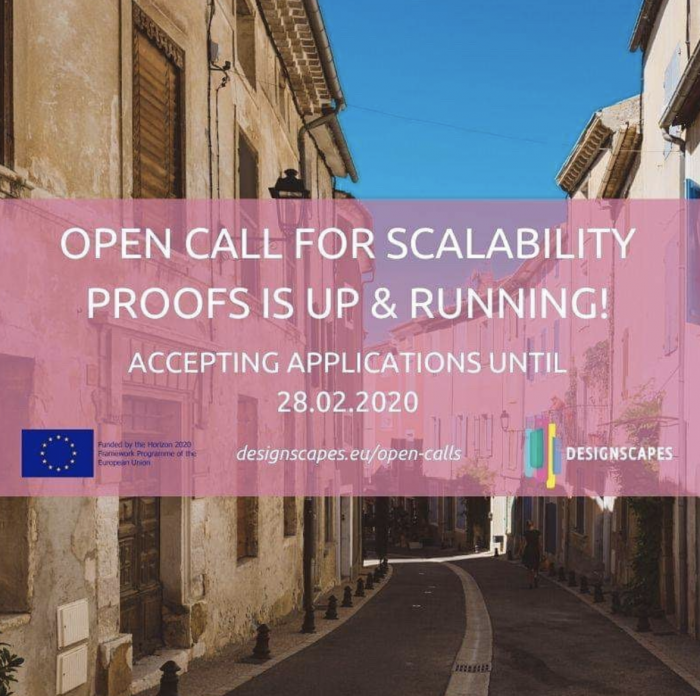I. SUMMARY INFORMATION
Project
268049
Status
Submitted
Award category
Reinvented places to meet and share
You want to submit
NEW EUROPEAN BAUHAUS AWARDS : existing completed examples
Project title
Design enabled Innovation in EU Cities
Full project title
DESIGNSCAPES - Building Capacity for Design enabled Innovation in Urban Environments
Description
Based on the lessons learned in this EU funded project a new design innovation policy needs broadening in five aspects, including:
The scope of design beyond form-giving and aesthetic orientation
The scope of design-driven innovation beyond aesthetic and soft innovation
The agents of innovation beyond the business and SMEs
Policy goal setting beyond productivity and firm performance
Policy action taking beyond individual and organizational levels.
Where was your project implemented in the EU?
Italy
Tuscany
Viale della Giovine Italia 17
Firenze
50122
When was your project implemented?
Has your project benefited from EU programmes or funds?
Yes
Which programme(s) or fund(s)? Provide the name of the programme(s)/fund(s), the strand/action line as relevant and the year.
H2020-CO-CREATION-02-2016 - User-driven innovation: value creation through design-enabled innovation
II. DESCRIPTION OF THE PROJECT
Please provide a summary of your project
The overarching aim of the DESIGNSCAPES project is to demonstrate the generative potential of urban environments to the uptake, enhancement and upscaling of Design enabled Innovation (DeI) by existing enterprises, start-up companies, public authorities and agencies, academia, and other urban stakeholders. Our definition of DeI stresses the exploitation of expert and diffused design skills and approaches to enhance value creation by shaping a shared view of issues and challenges, while producing new functions, uses and meanings through a multi-disciplinary, multi-level and networked process of transition towards systemic change.
During 4 years of work the project team has experimented with two different forms of support to DeI, namely:
A cascade funding initiative that has co-financed 99 small sized, transformative projects in three distinct phases (feasibility studying, prototyping and scalability proofing);
A capacity building programme to articulate the changing role of design for innovation in urban environments, acting as an infrastructuring mechanism in a self-sustaining way;
Resulting in:
Extended access to design methods and tools and training modules to 51 call winners;
The publication of a Green Paper on DeI in urban environments, which eventually supported a White Paper for the definition of future EU design policies;
The successful transfer of the DESIGNSCAPES concept to support the nomination of Valencia as World Design Capital in 2022.
The lessons learned from this experience include the core value of DeI to strengthen the co-creation capacity of citizens / users in the making of all types of innovation in cities. It emphasizes design as an infrastructuring mechanism that facilitates the involvement of design experts and users in all phases of the maturity of niche innovations, ultimately supporting a long-term systemic change.
Please give information about the key objectives of your project in terms of sustainability and how these have been met
DESIGNSCAPES tested a flexible and sustainable funding scheme, which will ultimately be packaged and handed over to interested policy makers. Its main characteristics include its being:
Instrumental: to promoting DeI in Cities, avoiding to reward the WHAT per se, but more the HOW (and WHERE) an innovative output is reached;
Neutral: with respect to the innovation type (i.e. product, service, process, policy, etc.), provided the novelty and originality of it are well preserved;
Scalable: the same scheme can be adopted at local, regional, national or European levels without substantial variations; the same application form (and in part, evaluation criteria) can be used for feasibility studies, prototypes or scalability proofs;
Parsimonious: can document very high “ROI” (ratios between investments mobilized by the beneficiaries and public outlays per granted initiative); as it adopts “long tail” mechanisms, giving preference to funding many applicants with small amounts instead of the opposite;
IT supported: not only proposal submission and evaluation, but the assessment process itself can be handed over to a machine in full, in line with the emerging principles of Artificial Intelligence;
Result oriented: unless they deliver precise outputs, in compliance with stated specifications, applicants do not receive the promised grant at the end of the development period;
Easy to access: evidence has shown positive feedback from the applicants, both in quantitative terms (huge attendance figures with relatively little advertising) and in qualitative terms, including an unexpected capacity of “playing” with the three merged concepts of Design, Innovation and City;
Distinctive: several traits are quite unique in the current panorama of State aid regimes, such as a voucher mechanism for granting feasibility studies, an integrated toolbox and training programme for beneficiaries, or the explicit attention to the cross-City scaling of innovation.
Please give information about the key objectives of your project in terms of aesthetics and quality of experience beyond functionality and how these have been met
The innovative approach to DeI developed in the DESIGNSCAPES project involves four key features:
It is a human-centered activity incorporating users into different phases of the innovation process;
It makes use of specific operational tools to research, contextualize, model, test and re-design;
It bridges multi-disciplinary knowledge of scientific, synthetic, symbolic and managerial bases;
It is a holistic approach encompassing different aspects of innovation, like functionality, meaning, cost, diversity, accessibility etc.
People are placed at the heart of innovation generation processes, emphasizing design as an infrastructuring mechanism that establishes supportive collaborative working conditions for smooth and efficient co-creation with a variety of disciplines and stakeholders, including both diffuse design and expert design. Engaging people in co-creation makes full use of users/citizens experience, perspective and knowledge to jointly frame problems, generate ideas, develop prototypes, and deliver final solutions that reflect user expectation and needs, ultimately creating value for them.
Understanding how to tackle urban challenges needs to be a collaborative effort that builds on collective knowledge and diverse perspectives. Hence the capacity building programme contributed to the establishment of local Quadruple Helix networks of practice.
This approach is coherent with the goals of the New European Bauhaus initiative, seeking to transform European "places" into more sustainable, inclusive and high-quality living environments for jointly building EU's future in a more creative, participatory, and design-led way. This leads to broadening the scope of design beyond form-giving and aesthetic orientation. Design should be recognized as a problem-solving approach and co-design should be promoted as a key design capability to support public participation and co-creation, in turn leading to innovative results, particularly in our cities.
Please give information about the key objectives of your project in terms of inclusion and how these have been met
As the DESIGNSCAPES open calls incorporate “social inclusion” into their evaluation criteria, successful applicants, especially from the business sector, were possibly led to overestimate the social value orientation of their initiatives and underestimate the pursuit of profit. This was not by chance. On the one hand, the kind of innovation pursued in the project acknowledges that the global challenges of modern times (such as climate change, ecological transition, demographic decline etc.) find an immediate instantiation in the local community crises and a close correspondence with the well known concept of "wicked problems" that an inclusive approach to design is expected to tackle at its best.
Solving these problems requires both a global vision and local intelligence that allow to put common understandings of problems into contexts and to develop different identity practices according to the urban environments. Citizens and other Quadruple Helix stakeholders are driven to play a crucial role in identifying and actively intervening in urban challenges through offering new perspectives and original solutions that only collective creativity can generate to the extent required.
Therefore, a challenge based innovation approach has the best chances of conveying other benefits than simply the realization of profit. However, even in this situation, it remains crucial that DeI delivers solutions that people will love to use, which also ensures a greater market success to related products and services. In other words, the two impacts - societal and business - coexist and reciprocally influence each other, as also witnessed by a plethora of innovative initiatives around the world that are entirely and exclusively committed to sustainability, equity and and the provision of public and shared value.
Please give information on the results/impacts achieved by your project in relation to the category you apply for
A total of 487 proposals were received from all over Europe, 101 of which were eventually supported by the EU CSA cascade funding scheme, coming from 58 cities in 20 European countries. Only two of them withdrew after the award of the EU grant. Overall, these DeI initiatives are generally dispersed but also geographically concentrated in some countries and regions. Western and Northern Europe are the areas with the highest concentration, while Southern Europe, especially along the Mediterranean coast, has the widest distribution of initiatives. Denmark is the most active of the Nordic countries in the implementation of DeI while Slovenia and Bulgaria are two hotspots of Eastern Europe. Over 25% of all funded projects gave priorities to a range of urban issues from urban renewal and renovation to the optimization of public spaces, smart cities and mobility, and affordable housing; 20% of them focused on socio-economic themes like new business models, social enterprising, employment creation, wealth distribution and equity. The environmental sustainability focus, including the fight to CO2 emissions and disaster and emergency management, accounted for 16% of the whole sample. Other minority topics included community identity and solidarity (13%), culture and gender (8%), health and well-being (7%), the inclusion of vulnerable groups (7%), values and democracy (3%). About 65% of initiatives aimed at new product or service developments, followed by objectives of organizational innovation (21%), process innovation (11%), and marketing innovation (3%). Half of the initiatives were implemented with an aim of solving local problems or reaching local markets, while the other half was shared by innovations in national and global markets, as well as in-house innovations of participant organizations, in equal proportions.
Please explain the way citizens benefiting from or affected by the project and civil society have been involved in the project and what has been the impact of this involvement on the project
More than half of the DeI projects were executed by small teams of 3-5 people, followed by medium-sized teams of 6-10 people, accounting for a quarter of them. Despite significant visibility at the feasibility stage, the number of micro-teams (1-2 staff) was increasingly reduced as the underlying innovation matures, especially at the scalability phase where their numbers were almost negligible. Large teams (10+ people) were under-represented at all stages of innovation. Although capital budgeting was very diverse ranging from €5,000 up to €50,000 at the feasibility study stage, the majority of initiatives needed a moderate investment between €20,000 and €50,000 at the prototyping and scalability stages, respectively, just followed by a small share needing a larger budget over 50,000 euros.
Business was the most significant sector in the DESIGNSCAPES community. More than 90% of firms were micro-enterprises (with fewer than 10 employees) and a further 10% were small enterprises (with 10 to 26 employees). Despite being for-profit organizations, 73% of firm innovations were undertaken in pursuit of market benefits while creating social and public value, with only 3% of them focusing on purely economic profits, while social enterprises for social innovation constituted 23% of all players in the sector. Individuals not affiliated with any organization were the second largest group of design-enabled innovators, constituting 18% of all applicants. The majority of them were design experts with significant design skills and experience whilst people with none or limited design experience only accounted for 15% of the group.
Civil society was also a growing force for innovation, representing 16% of our pilot sample of DeI projects, with evidence showing that 31% of scalability proofs and 19% of prototyping projects came from this sector. Finally, about 13% of all the proposals were presented by professors and students from EU academia.
Please highlight the innovative character of the project
Despite the close relationship between cities and innovation, the current EU design policy has a narrow industrial orientation aimed at increasing the innovation and competitiveness of firms based on the effective use of country-specific design resources, without taking into account neither the urban dimension nor systemic innovation goals. As a result, existing DeI initiatives are too geographically concentrated and most cities, particularly small and medium-sized towns that make up 56% of Europe’s population, fail to capture the innovation opportunities presented with the latest development of design theory and practices .
Additionally, most design-led initiatives are niche innovations that lack sufficient replication and scaling capability to achieve broader changes in the regime. In other words, the overall design innovation potential of European cities is not fully exploited now. Harnessing the innovation potential for European cities requires to put the city at the heart of design policy making.
All these examples explain that there is no need to create any new policy label or trademark like “design-enabled city” of its kind to highlight the significance of DeI in urban contexts; instead, European policy makers should align the current EU agenda and actions to the development of a next generation of design policy, including but not limited to the Urban Agenda for the EU and the New European Bauhaus Initiative, so as to disseminate and integrate design approaches and skills at the policy level beyond traditional individual and organizational levels.
The case of Valencia selected as World Design Capital 2022 with a concept fueled by the DESIGNSCAPES project, shows as a key pathway to sustainable transformation the creation (design) of an opportunity/occasion where bottom-up initiatives and top-down strategies can meet and be merged with a clear policy orientation.
Please explain how the project led to results or learnings which could be transferred to other interested parties
A key lesson is to develop mission-oriented design innovation policies to solve targeted global challenges and urban problems. Mission-oriented innovation policy stresses its alignment with grand but concrete challenges while at the same time targeting a specific outcome rather than steps in the innovation process. By applying a mission-oriented approach, urban policymakers should develop targeted design support policies with clear mission statements. Missions can either be based on global (such as UN’s SDGs) or EU agendas or driven by regional or local initiatives. The key aspect is to ensure the implementation and development of DeI projects in line with specific directions that city authorities want to achieve. By doing so, niche innovators can be motivated and integrated to work together, but in parallel and separate ways, to seek a diversity of solutions to specific challenges and problems. To make this transformation come true, cities should encourage initiatives from all sectors with concentrated efforts towards achieving “big things”. To this end, city governments should work closely with the business sector, civil society, academia, and citizens to ensure that urban innovation occurs in the direction of shared goals.
Systemic changes are always long-term and uncertain; an enhanced urban capacity for DeI can empower niche innovators and other urban stakeholders to develop strong enough resources to seize the window of opportunity to realize wider and deeper changes in the regimes and even landscapes of the future. Furthermore, local governments play an irreplaceable role in fostering DeI in urban environments, besides the joint efforts of the local design community, business sector, and universities. This implies that DeI should be strengthened at policy level beyond individual and organizational levels, which in turn asks for internalizing design into the policy making process in addition to public administration innovation.
Is an evaluation report or any relevant independent evaluation source available?
No
III. UPLOAD PICTURES
IV. VALIDATION
By ticking this box, you declare that all the information provided in this form is factually correct, that the proposed project has not been proposed for the Awards more than once under the same category and that it has not been subject to any type of investigation, which could lead to a financial correction because of irregularities or fraud.
Yes
